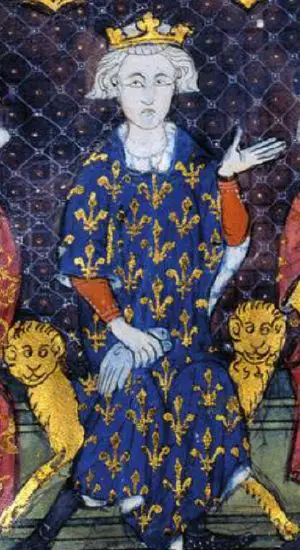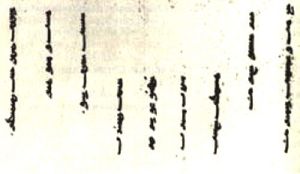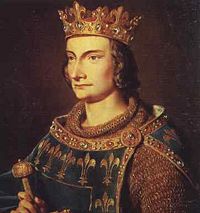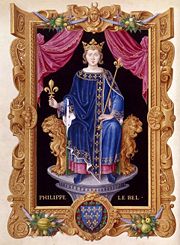Philip IV The Fair
| Philip IV the Fair | ||
|---|---|---|
| King of France (more...) | ||

| ||
| Philippe IV, recumbent statue on his tomb, royal necropolis, Saint Denis Basilica | ||
| Reign | October 5, 1285 – November 29, 1314 | |
| Coronation | January 6, 1286, Reims | |
| Titles | Jure Uxoris Count of Champagne (1284 – 1305) Jure Uxoris King of Navarre (1284 – 1305) | |
| Born | 1268 | |
| Fontainebleau, France | ||
| Died | 29 November, 1314 | |
| Fontainebleau, France | ||
| Buried | Saint Denis Basilica | |
| Predecessor | Philip III | |
| Successor | Louis X | |
| Consort | Joan I of Navarre (1271–1305) | |
| Issue | Louis X (1289–1316) Philip V (1293–1316) Charles IV (1294–1328) Isabelle, Queen of England (c.1295–1358) | |
| Royal House | House of Capet | |
| Father | Philip III (1245–1285) | |
| Mother | Isabella of Aragon (1247–1271) | |
Philip IV (1268 – November 29, 1314), called the Fair (French: le Bel), son and successor of Philip III, reigned as King of France from 1285 until his death. He was the husband of Joan I of Navarre, by virtue of which he was King of Navarre (as Philip I) and Count of Champagne from 1284 to 1305. Philip consolidated the Capetian monarchy's rule, controlling a larger territory than any of his predecessors. Always in debt, however, he impoverished the country to pay for his military exploits as well as for his lavish lifestyle. France's debt was not entirely his fault, since he inherited debts from his father's wars against the English and against Flanders. Convinced that, as King, he ruled as God's divinely anointed representative, he locked himself in a fierce power struggle with the papacy. In 1305, he engineered the election of Clement V, whom he could manipulate. In 1309, Clement transferred his residence to Avignon, beginning what became known as the "Babylonian captivity of the Popes." Philip may be best known for forcing Clement to dissolve the Knights Templar, whom he accused of all sorts of heretical beliefs and practices. On the other hand, Philip did much to strengthen the mechanism of governance in France by developing a bureaucracy, and by helping to shape the emergence of France as a nation consisting of more than Paris and its surrounding territory.
Youth
A member of the House of Capet, Philip was born at the Palace of Fontainebleau at Seine-et-Marne, the son of King Philip III and Isabella of Aragon. Philip was nicknamed the Fair (le Bel) because of his handsome appearance, but his inflexible personality gained him other epithets, from friend and foe alike. His fierce opponent Bernard Saisset, bishop of Pamiers, said of him, "He is neither man nor beast. This is a statue"[1]
His education was guided by Guillaume d'Ercuis the almoner of his father.
As prince, just before his father's death, he negotiated the safe passage of the royal family out of Aragon after the unsuccessful Aragonese Crusade.
Consolidation of the royal demesne
As a king, Philip was determined to strengthen the monarchy at any cost. He relied, more than any of his predecessors, on a professional bureaucracy of legalists. Because to the public he kept aloof and left specific policies, especially unpopular ones, to his ministers, he was called a "useless owl" by his contemporaries. His reign marks the French transition from a charismatic monarchy – which could all but collapse in an incompetent reign – to a bureaucratic kingdom, a move towards modernity. While the early Capetians had ruled only Paris and its environs, Philip's power extended over most of what would later be the nation state of France. The firmness with which he ruled helped to create that sense of nationhood.
Philip married queen Jeanne of Navarre (1271–1305) on August 16, 1284. The primary administrative benefit of this was the inheritance of Jeanne in Champagne and Brie, which were adjacent to the royal demesne in Ile-de-France and became thus effectively united to the king's own lands, forming an expansive area. During the reigns of Jeanne herself, and her three sons (1284–1328), these lands belonged to the person of the king; but by 1328 they had become so entrenched in the royal domain that king Philip VI of France (who was not an heir of Jeanne) switched lands with the then rightful heiress, Joan II of Navarre, with the effect that Champagne and Brie remained part of the royal demesne and Joan received compensation with lands in western Normandy.
The Kingdom of Navarre in the Pyrenees was not so important to contemporary interests of the French crown. It remained in personal union 1284–1329, after which it went its separate way. Philippe gained Lyon for France in 1312.
Contacts with the Mongols
Philip had various contacts with the Mongol power in the Middle East, who were trying to obtain the cooperation of Christian powers to fight against the Muslims. He received the embassy of the Mongolian Chinese monk Rabban Bar Sauma, and an elephant as a present.[2]. Philip seemingly responded positively to the request of the embassy:
"If it be indeed so that the Mongols, though they are not Christians, are going to fight against the Arabs for the capture of Jerusalem, it is meet especially for us that we should fight [with them], and if our Lord willeth, go forth in full strength."
"The Monks of Kublai Khan Emperor of China[3]
Philip also gave the embassy numerous present, and sent one of his noblemen, Gobert de Helleville, to accompany Bar Sauma back to Mongol lands:
"And he said unto us, "I will send with you one of the great Amirs whom I have here with me to give an answer to King Arghon"; and the king gave Rabban Sawma gifts and apparel of great price."
"The Monks of Kublai Khan Emperor of China[4]
Gobert de Helleville departed on February 2, 1288, with two clerics, Robert de Senlis and Guillaume de Bruyères, as well as arbaletier Audin de Bourges. They joined Bar Sauma in Rome, and accompanied him to Persia.
The Mongol ruler Arghun, based in Baghdad, further wrote to him a letter in 1289, in answer to a letter sent by Philip to him in 1288, specifically outlining military cooperation:
By the might of Eternal God, under the auspices of Khagan Argoun, our word: King of France, by the envoy Mar-Bar Sevma Sakhora, you have summoned me.
- When the Ilkhan's troops march against Egypt, we shall set off from here to join them. Having received this message from you, I have said that we would propose, placing our confidence in God, to set out in the last month of winter in the year of the TIger (January 1291), and camp before Damascus towards the 15th of first month of spring (around 20 February). If you keep you word and send your troops at the agreed time, and if God is with us, when we have taken Jerusalem from these people we shall hand it over to you. To miss the rendezvous, however, would mean moving the troops in vain: would this suit you? And if, furthermore, one of us is not ready to act with the other, what advantage could he obtain? I have sent Mouskeril the Tchurtchi who will tell you that if you send us ambassadors conversant with several languages and who bring us rare and pleasant gifts from France with paintings of different hues, we shall be most grateful to you, by almighty God and the fortune of the Khagan. [5]
Contrary to Saint Louis, Philip apparently did not pursue with such military plans in the Middle East in the form of a Crusade. He did however organize a military collaboration with the Mongols through the Knights Templar and their leader Jacques de Molay against the Mamluks. The plan was to coordinate actions between the Christian military orders, the King of Cyprus, the aristocracy of Cyprus and Little Armenia and the Mongols of the khanate of Ilkhan (Persia). In 1298 or 1299, Jacques de Molay halted a Mamluk invasion with military force in Armenia possibly because of the loss of Roche-Guillaume, the last Templar stronghold in Cilicia, to the Mamluks. However, when the Mongol khan of Persia, Ghâzân, defeated the Mamluks in the Battle of Wadi al-Khazandar in December 1299, the Christian forces were not ready to take an advantage of the situation.
In 1300, Jacques de Molay ordered his Knights to commit raids along the Egyptian and Syrian coasts to weaken the enemy's supply lines as well as to harass them, and in November that year he joined the occupation of the tiny fortress island of Ruad (today called Arwad) which faced the Syrian town of Tortosa. The intent was to establish a bridgehead in accordance with the Mongol alliance, but the Mongols failed to appear in 1300. The same happened in 1301 and 1302. News circulated in Europe that the Mongols had finally conquered the Holy Land and Jerusalem in 1300, and handed it over to the Christians, but this apparently did not happen.[6]
In September 1302 the Knights Templar were driven out of Ruad by the attacking Mamluk forces from Egypt, and many were massacred when trapped on the island. The island of Ruad was lost, and when Ghâzân died in 1304 dreams of a rapid reconquest of the Holy Land were destroyed.
In April 1305, the new Mongol ruler Oljeitu sent letters to Philip,[7] the Pope, and Edward I of England. He again offered a military collaboration between the Christian nations of Europe and the Mongols against the Mamluks. European nations accordingly prepared a crusade, but were delayed, and the crusade never took place. In the meantime Oljeitu launched a last campaign against the Mamluks (1312-1313), in which he was unsuccessful. A settlement with the Mamluks would only be found when Oljeitu's son signed the Treaty of Aleppo with the Mamluks in 1322.
War with the English
The outbreak of hostilities with England in 1294 was the inevitable result of the competitive expansionist monarchies, triggered by a secret Franco-Scottish pact of mutual assistance against Edward I, who was Philip's brother-in-law, having married Philip's sister Marguerite; inconclusive campaigns for the control of Gascony to the southwest of France were fought in 1294–1298 and 1300–1303. Philippe gained Guienne but was forced to return it. No major war had been fought in Europe since the 'teens, and in the interim the nature of warfare had changed: it had become more professional, technologically more advanced and much more expensive. The search for income to cover military expenditures set its stamp on Philip's reign and his contemporary reputation. Pursuant to the terms of the Treaty of Paris (1303), the marriage of Philip's daughter Isabella to the Prince of Wales, heir of Philip's enemy, celebrated at Boulogne, January 25, 1308, was meant to seal a peace; instead it would produce an eventual English claimant to the French throne itself, and the Hundred Years War.
The drive for income
In the shorter term, Philip arrested Jews so he could seize their assets to accommodate the inflated costs of modern warfare: he expelled them from his French territories in 1306. His financial victims included Lombard bankers and rich abbots. He was condemned by his enemies in the Catholic Church[8] for his spendthrift lifestyle. In June, he debased the coinage. Such was the public outcry that Philip was forced, during nine days of riots in Paris, to seek refuge in the Paris headquarters of the Knights Templar. While there, he and his entourage are said to have consumed "eight hundred and six pounds of bread and two-thousand and seventy litres of wine" even though he could not balance his own books at the time. [9] When he also levied taxes on the French clergy of one half their annual income, he caused an uproar within the Roman Catholic Church and the papacy, prompting Pope Boniface VIII to issue the Bull Clericis laicos, forbidding the transference of any church property to the French Crown and prompting a drawn-out diplomatic battle with the King. In order to condemn the pope, Philip convoked an assembly of bishops, nobles and grand bourgeois of Paris, a precursor to the Etats Généraux that appeared for the first time during his reign, a measure of the professionalism and order that his ministers were introducing into government. Philip emerged victorious, after having sent his agent William Nogaret to arrest Boniface at Anagni, when the French archbishop Bertrand de Goth was elected pope as Clement V and the official seat of the papacy moved to Avignon, an enclave surrounded by French territories, commencing the captive Avignon Papacy (1309-1378).
Philip's Understanding of the Monarchy
Philip, indeed the Capetian dynasty, regarded the king as God's representative on earth. This ran counter to the teaching of the Catholic Church at the time that the Pope was God's representative in both the temporal and the spiritual realm. According to Howarth, the Capetian kings believed themselves, or were believed to be by their subjects, "semi-divine" whose "touch, reputedly, could cure disease." [10]In his self-understanding, Philip was a "priest-king" and so felt entitled to tax the clergy, even though this contravened papal authority. It was this self-understanding that brought Philip into direct conflict with Pope Boniface VIII, "whose will was as strong as Philip's, and whose dream was identical, the union of all authority, temporal and spiritual, in his person" [11]. He regarded the "French throne to be more sacred than the papal throne" and so did not hesitate to arrest the Pope. [12]. This laid the ground for what Martin Luther called the "babylonian captivity of the Popes." Clement V, Philip's captive Pope, was a "weak, greedy man, fond of honor and disliking responsibility" who, unlike Boniface, could be easily manipulated [13]. Clement absolved Philip of any wrongdoing against the Church. Philip did, however, convene the first-ever meeting of what was called the "estates-general." This consisted of the feudal stakeholders, including barons, prelates and also scholars of the University of Paris. It was advisory but was also a tool that Philip used to recruit troops and to collect taxes.
In Flanders
Philip suffered a major embarrassment when an army of 2,500 noble men-at-arms (Knights and Squires) and 4,000 infantry he sent to suppress an uprising in Flanders was defeated in the Battle of the Golden Spurs near Kortrijk on July 11, 1302. Philip reacted with energy to the humiliation and personally defeated the Flemings at Mons-en-Pévèle two years later. Finally, in 1305, Philip forced the Flemish to accept a harsh peace treaty after his success at the battle of Mons-en-Pévèle; the peace exacted heavy reparations and humiliating penalties, and added the rich cloth cities of Lille and Douai, sites of major cloth fairs, to the royal territory. Béthune, first of the Flemish cities to yield, was granted to Mahaut, Countess of Artois, whose two daughters, to secure her fidelity, were married to Philip's two sons.
Suppression of the Knights Templar
Philip had long coveted the wealth of the Knights Templar. In 1305, when his acquaintence, the Spanish mystic and evangelist to Muslims, Ramon Lull published his Liber de fine, he favored the proposal, contained in that text, for the combination of the Templars with the Hospitallers under the authority of a king, or of the son of a king. Philip saw himself in this role, which would give him control of the wealth of both orders [14]. The same year, he applied for membership of the Templars but was refused. Although discussed, Lull's proposal did not attract enough support. Philip then adopted a different strategy and informed Clement that the Templars were guilty of all sorts of heretical beliefs and practices. When Clement did not move against the Order, he did so himself. On Friday, October 13, 1307, hundreds of Knights Templar in France were simultaneously arrested by his agents, to be later tortured into admitting heresy in the Order[15]. (This is one of the reasons why Friday the 13th is seen as unlucky. The Knights Templar were a 200-year-old military order, supposedly answerable only to the Pope. Philip accused them of defiling the crucifix by urinating on it, calling Jesus a false prophet, of sodomy, of worshipping a cat, as well as of practicing magic. Philip used his influence over Clement V, who was largely his pawn, to disband the order and remove its ecclesiastical status and protection in order to plunder it.
A modern historical view is that Philip seized the considerable Templar treasury and broke up the Templar monastic banking system. In 1314, he had the last Grand Master of the Templars, Jacques de Molay, burnt at the stake in Paris. According to legend, de Molay cursed both Philip and Clement V from the flames, saying that he would summon them before God's Tribunal within a year; as it turned out, both King and Pope died within the next year.
Philip IV's rule signaled the decline of the papacy's power from its near complete authority. His palace located on the Île de la Cité is represented today by surviving sections of the Conciergerie. He died during a hunt when he was mauled by a wild boar and is buried in Saint Denis Basilica. He was succeeded by his son Louis X.
Ancestors
| Philip IV of France | Father: Philip III of France |
Paternal Grandfather: Louis IX of France |
Paternal Great-grandfather: Louis VIII of France |
| Paternal Great-grandmother: Blanche of Castile | |||
| Paternal Grandmother: Marguerite of Provence |
Paternal Great-grandfather: Ramon Berenguer IV, Count of Provence | ||
| Paternal Great-grandmother: Beatrice of Savoy | |||
| Mother: Isabella of Aragon |
Maternal Grandfather: James I of Aragon |
Maternal Great-grandfather: Peter II of Aragon | |
| Maternal Great-grandmother: Marie of Montpellier | |||
| Maternal Grandmother: Violant of Hungary |
Maternal Great-grandfather: Andrew II of Hungary | ||
| Maternal Great-grandmother: Violant of Courtenay |
Children
The children of Philip IV and Jeanne of Navarre were:
- Marguerite (1288–1300)
- Louis X - (October 4, 1289–June 5, 1316)
- Philip V - (1291–January 3, 1322)
- Isabelle - (c. 1292–August 23, 1358)
- Charles IV - (1294–February 1, 1328)
- Robert (1297–1308)
All three of his sons reaching adulthood would become kings of France, and his daughter, as consort of Edward II, was queen of England.
See also
- Guillaume de Nogaret
- Enguerrand de Marigny
Notes
- ↑ "Ce n'est ni un homme ni une bête. C'est une statue."; see Stephen Howarth. The Knights Templar. (NY: Barnes & Noble, 1982), 252
- ↑ "Philippe le Bel," Histoire Philippe le Bel Retrieved September 8, 2007.
- ↑ Sir E. A Wallis Budge. The Monks of Kublai Khan, (London: Religious Tract Society, 1928) The Monks of Kublai Khan. Retrieved September 8, 2007.
- ↑ Budge. The Monks of Kublai Khan, (London: Religious Tract Society, 1928) The Monks of Kublai Khan. Retrieved September 8, 2007.
- ↑ "Letter from Argun, Mongol Khan of Persia, to Philppe le Bel, King of France" Letter from Argun, Mongol Khan of Persia, to Philppe le Bel, king of France.
- ↑ Sylvia Schein, "Gesta Dei per Mongolos 1300. The Genesis of a Non-Event." The English Historical Review 94 (373) (Oct., 1979): 805
- ↑ Jean Calmard, "France" Encyclopedia Iranica, France. Retrieved September 8, 2007.
- ↑ Contemporary chroniclers were all monks.
- ↑ Howarth, 268
- ↑ Howarth, 252
- ↑ Howarth, 254
- ↑ Howarth, 256
- ↑ Howarth, 261
- ↑ Howarth, 260
- ↑ Malcolm Barber. The Trial of the Templars. (Cambridge: Cambridge University Press, 1978. ISBN 0521457270).
ReferencesISBN links support NWE through referral fees
- Denton, Jeffrey Howard. "Philip the Fair and the Ecclesiastical Assemblies of 1294-1295." Transactions of the American Philosophical Society 81, pt. 1. Philadelphia: American Philosophical Society, 1991. ISBN 9780871698117
- Favier, Jean Philippe le Bel Paris: Fayard, 1978. ISBN 9782213006000
- Goyau, Georges. "Philip IV (the Fair)." The Catholic Encyclopedia, Volume XII. 1911. Philp IV the FairRetrieved September 8, 2007.
- Howarth, Stephen. The Kinghts Templar. NY: Barnes & Noble, 1982. ISBN 9780880296632
- Strayer, Joseph Reese. The Reign of Philip the Fair. Princeton, NJ: Princeton University Press, 1980. ISBN 9780691053028
External links
All links retrieved November 23, 2022.
| House of Capet Born: 1268; Died: 29 November 1314 | ||
|---|---|---|
| Preceded by: Philip III |
King of France 5 October, 1285–29 November, 1314 |
Succeeded by: Louis X |
| Preceded by: Blanche of Artois |
King of Navarre and Count of Champagne by marriage with Joan I of Navarre and Champagne (as 'Philip I') August 16, 1284–4 April, 1305 |
Succeeded by: Marguerite de Bourgogne |
Credits
New World Encyclopedia writers and editors rewrote and completed the Wikipedia article in accordance with New World Encyclopedia standards. This article abides by terms of the Creative Commons CC-by-sa 3.0 License (CC-by-sa), which may be used and disseminated with proper attribution. Credit is due under the terms of this license that can reference both the New World Encyclopedia contributors and the selfless volunteer contributors of the Wikimedia Foundation. To cite this article click here for a list of acceptable citing formats.The history of earlier contributions by wikipedians is accessible to researchers here:
The history of this article since it was imported to New World Encyclopedia:
Note: Some restrictions may apply to use of individual images which are separately licensed.


